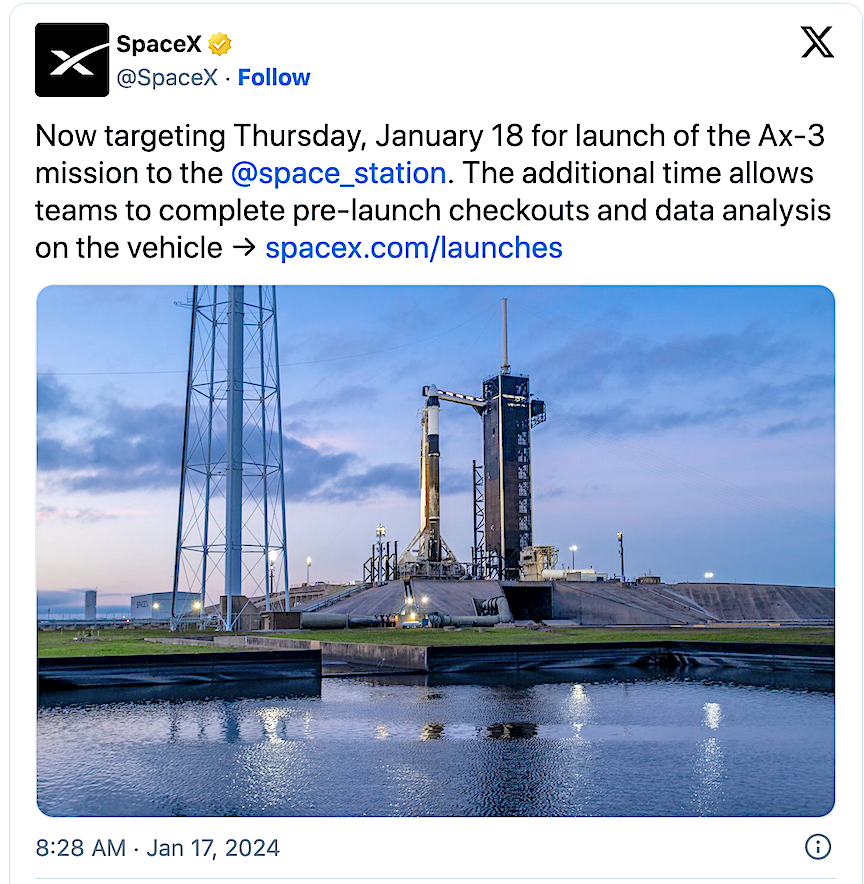
After one day’s delay, SpaceX on Thursday, January 18 launched Falcon 9’sAxiom Space’s Axiom Mission 3 (Ax-3) to the International Space Station from Launch Complex 39A (LC-39A) at NASA’s Kennedy Space Center in Florida. The instantaneous launch window is at 4:49 p.m. ET.
Wednesday’s launch was delayed due to concerns Axiom had.

The Axiom statement said some of the needed analysis was with the parachute system energy modulator. “It sounds like there are some concerns still to make sure that the parachutes are ready to safely return the capsule to the Earth at the end of the mission.”
UPDATE: SpaceX scrubs Axiom’s launch of first all European commercial astronauts to ISS

SpaceX is targeting no earlier than Thursday, January 18 for Falcon 9’s launch of Axiom Space’s Axiom Mission 3 (Ax-3) to the International Space Station from Launch Complex 39A (LC-39A) at NASA’s Kennedy Space Center in Florida. The instantaneous launch window is at 4:49 p.m. ET. If needed, an additional opportunity is available on Saturday, January 20 at 4:00 p.m. ET.
A live webcast of this mission will begin on X @SpaceX about two hours prior to launch. Watch live.
Safety is a big concern on any launch, and even more so with astronauts onboard, according to Dr. Don Platt of Florida Tech.
“Certainly, for a human mission, they are going to want to make sure that every “i” is dotted and “t” is crossed. So, if there’s some technical data that has not been closed out here, they definitely want to make sure that they are good to go before they put people on a rocket,” Platt said.
The Axiom statement said some of the needed analysis was with the parachute system energy modulator. “It sounds like there are some concerns still to make sure that the parachutes are ready to safely return the capsule to the Earth at the end of the mission,” added Dr. Platt.
“The additional time allows teams to complete pre-launch checkouts and data analysis on the vehicle,” SpaceX officials announced in a tweet.

Weather should remain favorable at the Cape. The Space Force’s 45th Weather Squadron has pegged the odds of “go for launch” weather for this backup chance at 80%.
Primary concerns include cumulus clouds, precipitation and weather conditions along the rocket’s ascent corridor in case the Dragon crew capsule has to abort and eject from the second stage.
The Dragon spacecraft supporting this mission previously flew Crew-4 and Ax-2 to and from the space station. Following stage separation, Falcon 9’s first stage will land on Landing Zone 1 (LZ-1) at Cape Canaveral Space Force Station.
During their time on the orbiting laboratory, the crew will conduct more than 30 scientific experiments and demonstrations focused on human physiology and technological industrial advancements.

SpaceX is targeting no earlier than Wednesday, January 17 for Falcon 9’s launch of Axiom Space’s Axiom Mission 3 (Ax-3) to the International Space Station from Launch Complex 39A (LC-39A) at NASA’s Kennedy Space Center in Florida. The instantaneous launch window is at 5:11 p.m. ET, with a backup opportunity available on Thursday, January 18 at 4:49 p.m. ET.
A live webcast of this mission will begin on X @SpaceX about two hours prior to launch. Watch live.
The Dragon spacecraft supporting this mission previously flew Crew-4 and Ax-2 to and from the space station. Following stage separation, Falcon 9’s first stage will land on Landing Zone 1 (LZ-1) at Cape Canaveral Space Force Station.
During their time on the orbiting laboratory, the crew will conduct more than 30 scientific experiments and demonstrations focused on human physiology and technological industrial advancements.
Mission patches are a symbolic expression of the mission objectives and a time-honored tradition dating back to the 1960s with the NASA Gemini program. They are designed and worn by the astronauts and people affiliated with each mission. Axiom Space continues the tradition with its commercial astronaut missions.

The Axiom Mission 3 (Ax-3) patch is shaped as a shield to illustrate strength and courage. The International Space Station (ISS) is centered and angled to be seen as aviator wings, symbolizing four astronauts piloting toward growth in low-Earth orbit (LEO) through the spirit of exploration and collaboration.
The Ax-3 crew is included at the forefront of the mission patch. The names of each crew member are seen in alphabetical order with flags of the countries they represent. The four stars next to the names represent the four European nations on the Ax-3 mission—Spain (Commander López-Alegría as a dual citizen of the U.S. and Spain), Türkiye, Italy, and Sweden.
The tiled Earth is shown with longitude and latitude lines to highlight the new frontier that the crew will explore and celebrate the power of bridging cultural divides to advance human knowledge and prosperity.
Located on the tiled Earth, toward the base of the patch, the number 100 denotes centennial milestones for Türkiye and Italy. Ax-3 will be a symbolic mission for Türkiye as the nation reflects on changes and progress made in the past century to advance economic development, education and technology, and the country’s global influence, now in space. This year, on March 28, 2023, the Italian Air Force celebrated its centennial anniversary as one of the oldest air forces in the world. This mission will serve as an opportunity to celebrate the Italian Air Force’s contribution to global security and stability.
The number 500 represents a jubilee year for Sweden as the country celebrated five centuries as an independent nation on June 6, 2023. The second Swedish ESA astronaut in history will fly to the space station during the Ax-3 mission, embodying opportunity and freedom to explore the unknown.
Located around the bottom edges of the patch, the mission’s moto “Further, Beyond” is written in Latin (PLVS VLTRA).
Ax-3 is the third commercial astronaut mission to the ISS and will carry the first crew of all-European national astronauts. With this crew, Europe is taking a visionary, leadership role in the future of commercial space.
